Oct 16, 2024 Why Names are Important & How to Honor Them
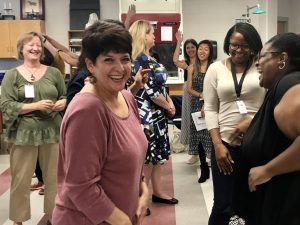 When groups come together for the first time, during the first weeks of school or the kick-off of fall programming, thoughtful educators and facilitators weave in intentional time to build community. Introductions, “name games,” and nametags are often part of this—for good reason.
When groups come together for the first time, during the first weeks of school or the kick-off of fall programming, thoughtful educators and facilitators weave in intentional time to build community. Introductions, “name games,” and nametags are often part of this—for good reason.
Names are everything. My practice is all about helping people build supportive, collaborative, and inclusive learning communities. Honoring each other begins with knowing each other’s names and using them with respect through correct pronunciation.
Our names hold our personal identity, our family history, and culture. They can also give us a sense of belonging. Preferred nicknames or new names chosen by an individual represent choice, control, and ownership. They can strengthen a sense of self. Honoring this sense of identity and choice promotes dignity, respect, and positive group culture.
Brain research has shown us the power of names in activating our brains. Neuroscience research demonstrates that hearing one’s name activates different parts of people’s brains as no other words do. In studies, even people in a vegetative state involuntarily responded to the sound of their own names.
As educators, we have tremendous potential to engage and connect with our learners, helping them feel valued and increasing their attention and focus simply by using their names correctly. Think about your own experiences with your name. When someone you recently met takes the time to remember and use your name correctly, doesn’t it help you feel appreciated and respected?
Dr. Angela M. Ward is a thought leader I admire in the education world who offers transformative resources for promoting equity in education. She emphasizes the importance of teachers making an effort to learn and correctly pronounce their students’ names because of the powerful role they play in the positive identity development of each student in their care.
This is why intentionally focusing on names and introductory activities can be so beneficial. However, thoughtful sequencing and ongoing facilitation of this practice are key to making it effective. Sometimes, educators and facilitators only address names in cursory ways on the first day of school or at a first meeting when participants aren’t comfortable yet with the group, so they are not in a place to speak up or correct mispronunciations or misuse of their name.
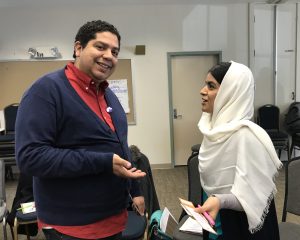 Many students and adults I’ve worked with over the years shared stories about how people in power have announced to the individual that they are going to change/adapt their names to make it easier for them as the leader/facilitator/teacher – without giving them any choice in the matter. I have often worked with groups that supposedly knew each other well, such as a faculty team who has been working together for a long time or a classroom group midway through a school year, but found that names were being mispronounced or misused. Even in the small schools I encounter in rural areas—where educators might assume students already know each other’s names—many actually don’t or are not always using and honoring names in a respectful way. I have found the same to be true with adults in the workplace.
Many students and adults I’ve worked with over the years shared stories about how people in power have announced to the individual that they are going to change/adapt their names to make it easier for them as the leader/facilitator/teacher – without giving them any choice in the matter. I have often worked with groups that supposedly knew each other well, such as a faculty team who has been working together for a long time or a classroom group midway through a school year, but found that names were being mispronounced or misused. Even in the small schools I encounter in rural areas—where educators might assume students already know each other’s names—many actually don’t or are not always using and honoring names in a respectful way. I have found the same to be true with adults in the workplace.
That is why I am sharing this article from my blog archives now, a couple of months into fall programming and the school year, to remind educators and facilitators that this is not a “one and done” activity but rather an ongoing effort to build community, respect, and honoring of peers.
Thoughtfully Sequencing Name Activities
Warm the group up first!
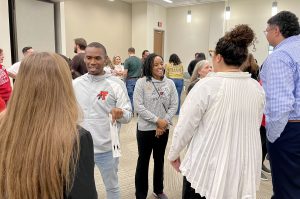 I try to avoid contrived name activities that put people “on the spot” too early or make them feel pressure to memorize or perform—especially early on in group development. I often begin with small group and partnering activities before moving to a whole group activity or discussion in order to build comfort with group process, sharing, and dialogue. My previous posts, such as “Start Off With Style,” offer simple, non-threatening, partner-matching techniques using props and simple reflective and get-to-know-you questions that are useful for this crucial first step.
I try to avoid contrived name activities that put people “on the spot” too early or make them feel pressure to memorize or perform—especially early on in group development. I often begin with small group and partnering activities before moving to a whole group activity or discussion in order to build comfort with group process, sharing, and dialogue. My previous posts, such as “Start Off With Style,” offer simple, non-threatening, partner-matching techniques using props and simple reflective and get-to-know-you questions that are useful for this crucial first step.
Carefully curated and facilitated activities help groups of all ages practice names and explore the concepts of connecting with others, honoring their peers’ strengths and personalities, and showing respect for individual identity and choice. In my book and blog, I’ve shared my tried-and-true activities to help groups learn, practice, and reinforce names in a meaningful but playful, non-threatening, and palatable way. “Name Meanings” is my favorite.
Name Meanings Activity
We can remember a person’s name more easily when we have meaningful information associated with it. When participants already know each other’s names, this activity can help them learn more about each other and lead to a discussion about the importance of honoring a person’s name (i.e., pronouncing it correctly, using it appropriately, and showing respect for each other). This activity works best after a few warm-up techniques like the Handshake Mingle once the group is more comfortable and willing to share.
Facilitation Suggestions:
- First, I use this activity after I have done a warm-up, a connection activity, and a welcoming activity using objects, images, or quotes. I do this for a few reasons: Participants will be more willing to share in this circle when they have already built comfort with the group. Secondly, when they still have the entry reflection object or image in hand, it will naturally give group members something to talk about with their name if they choose (see bullet five).
- I begin this activity by asking the group if they have ever had an experience where someone in the community’s name was repeatedly mispronounced or misused. When I ask this question, hands are ALWAYS raised, and I often notice that more introverted group members—who themselves have struggled with others mispronouncing their names—raise their hands or nod their heads.
- After this acknowledgment, I explain that is why I love this next activity: It is a way to honor each other by clarifying, celebrating, and learning to address each other by our preferred names.
- If a group needs an energizer, I sometimes ask members to line up silently by the number of letters in their name or preferred nickname. But this is not necessary.
- Next, I ask the group to form a circle and take turns sharing the following: First and most importantly, their preferred version of their name and correct pronunciation so that we can honor them by using it correctly. Second, I invite them to share anything they would like to about the story of their name. This could be the origin, meaning, cultural history, whether it is a family name, or their reasons for shortening it or using a nickname.
- I emphasize that sharing a story isn’t necessary if they don’t have one to share. Because I always facilitate this activity after they have engaged in an object/image welcoming activity, they will have something else to share if they choose, like their quote/button/tool from our previous welcoming activity. Or, I make it clear they can share simply their name—whatever they are comfortable sharing.
- Most importantly, this is an opportunity for participants to take ownership and share with the group the CORRECT pronunciation or nickname, something that often needs to be emphasized in school settings.
Outcomes/Reflections:
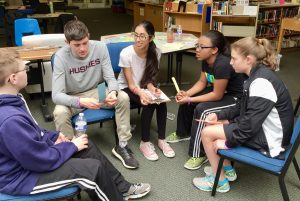 Learners of all ages say they prefer this activity to other name games because they get to share factual information. They don’t have to think of contrived additional information (e.g., a favorite fruit that begins with the same letter as their name). It even works with large groups. People want to listen and share this kind of personal information even if it takes some time—we are all naturally curious and want to hear each other’s stories.
Learners of all ages say they prefer this activity to other name games because they get to share factual information. They don’t have to think of contrived additional information (e.g., a favorite fruit that begins with the same letter as their name). It even works with large groups. People want to listen and share this kind of personal information even if it takes some time—we are all naturally curious and want to hear each other’s stories.
I have successfully used this activity with all age groups. Even very young children know about their names’ origins and feel strongly about what they want to be called.
Again and again, I find that this activity leads to meaningful group conversations and builds positive group norms. Often, the group discovers that colleagues or peers have been addressing a group member incorrectly for months or years, and that person has not spoken up.
 Once, when I was working with a school’s faculty, a teacher who had been at the school for 25 years revealed that although her colleagues had been calling her “Patty” for two decades, no one else in her life called her “Patty.” In fact, she preferred “Patricia.”
Once, when I was working with a school’s faculty, a teacher who had been at the school for 25 years revealed that although her colleagues had been calling her “Patty” for two decades, no one else in her life called her “Patty.” In fact, she preferred “Patricia.”
It turned out that a secretary had arbitrarily shortened Patricia’s name when setting up email addresses 20 years ago, and it stuck. Patricia hadn’t felt comfortable correcting her peers for all of those years until she was given the opportunity during this activity!
Name Meanings can lead to compelling reflection on identity, culture, and history. I’ve seen this working with Indigenous groups, teachers at a local school for the deaf and hard of hearing, and youth in foster care, where we had impactful discussions about honoring names, the place of names in personal identity and American culture, reclaiming names, and more.
In one discussion, a teacher said, “For years, when I’ve had students with the same name in my class, I have assigned them nicknames like Michael, Mike, and Mike A., without asking their preference. I will never do that again.”
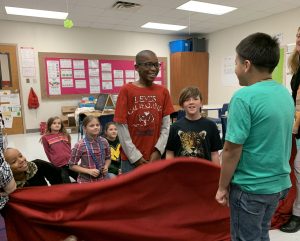 Taking the time upfront to build community through learning and practicing names pays off later. Many adult participants have told me that because they participated in the Handshake Mingle activity followed by Name Meanings, they finally learned the name of the person they had been passing in the hallway for years. And, even months after the in-service day, they often greet each other with the handshake greeting and check in with each other’s names when passing.
Taking the time upfront to build community through learning and practicing names pays off later. Many adult participants have told me that because they participated in the Handshake Mingle activity followed by Name Meanings, they finally learned the name of the person they had been passing in the hallway for years. And, even months after the in-service day, they often greet each other with the handshake greeting and check in with each other’s names when passing.
One high school student wrote, after doing these activities, “I am getting to know people better, and I can actually say ‘Hi’ to them in the hallway when before I didn’t have a clue who they were. And there is meaning behind the hello instead of a hello that means absolutely nothing.”
As Angela Ward states in her post on AntiRacist Teaching, “Teachers who are AntiRacist honor the dignity in the given name of each student in their care because they lead their classroom with love.”
References: I initially learned this activity many years ago from a group of teachers in Laconia, NH, and have developed the facilitation of it over time with input from participants. It is also described in my book Tips & Tools for the Art of Experiential Group Facilitation.
For more suggestions for name activities, visit past issues of the Inspired Educator blog or my book Inspired Educator, Inspired Learner.



No Comments